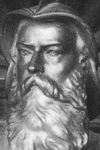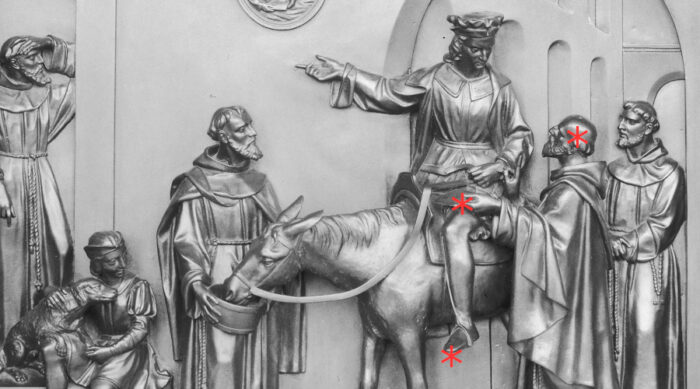
A few months ago, when I was looking for evidence of Washington – and the Capitol – as a magnet for newlyweds I came across an article in the Washington Evening Star of October 12, 1930 entitled “Columbus in Art in the U.S. Capitol.” As the title suggests, it looked at all the artworks “in Marble, Bronze and on Canvas” of the man who sailed the ocean blue in 1492 that are littered around the Capitol.
One of the pieces given a fair bit of ink is the Rogers door, which is on the east side of the rotunda. On it are eight scenes from Columbus’s life, and the door is both “the most elaborate door in the Capitol” and “is said to be the most celebrated bronze door on any public building in the world.”
While I am not in any way able to confirm or refute either of these statements, I can say that they were sculpted by Randolph Rogers, an American expatriate living in Italy. While finding pictures of him is difficult, the claim has been made that he used himself as a model for the statue of Bartholomew Columbus in the door, the head of which can be seen above.
Rogers was given the commission in 1855, then spent the next six years modeling and having the doors cast. While they were finished in 1861, they did not actually arrive in the US until 1863, and were not hung until 1871. They were used in different places in the Capitol, and became an interior door when the east front of the Capitol was extended in the 1950s.
However, this is not what I came here to write about. Instead, it is these paragraphs much deeper in the article that caught my eye:
The most popular panel of the Rogers door shows Columbus mounted on a horse before the convent of La Rabida. This is the “wishing scene,” and because of it the door is sometimes called the wishing door. There is a common superstition that good fortune will befall all those whose fingertips fall easily on the three designated spots – the bald head of the monk, Perez; the letter he is handing Columbus to Queen Isabelle, and the toe of the boot of Columbus. This formula is simple: Make a wish, then open the right hand, spreading the fingers fanwise. Rest the index finger on the letter and if the thumb falls into position on the boot and the little finger on the monk’s head, the wish will come true. It is a sure sign, they say, that the young lady tourist will return to Washington on her honeymoon, and the young man may become a Congressman, or President, who knows? He might as well wish big while he is at it! But alas! for those of us whose short gingers cannot span the specified area.

Every year thousands of tourists, and perhaps others, practicing this bit of hocus keep the magic spots on the wishing panel shining brightly by their constant fingering.
In spite of the Star’s insistence that this “bit of hocus” is well-known, there is no indication that it was written up anywhere else. No books, magazines, or other newspapers write of anything called the “wishing door,” either in the Capitol or anywhere else.
I have not had the opportunity to try this myself, and probably will not be even when the Capitol reopens – the eastern doorway of the Rotunda is not one where the Capitol guides allow you to tarry. If you do wish rub a statue, I can recommend the Einstein statue in front of the National Academies of Science – rubbing his nose is said to increase your intelligence.
